Log in or create new account to save this product to your wishlist.
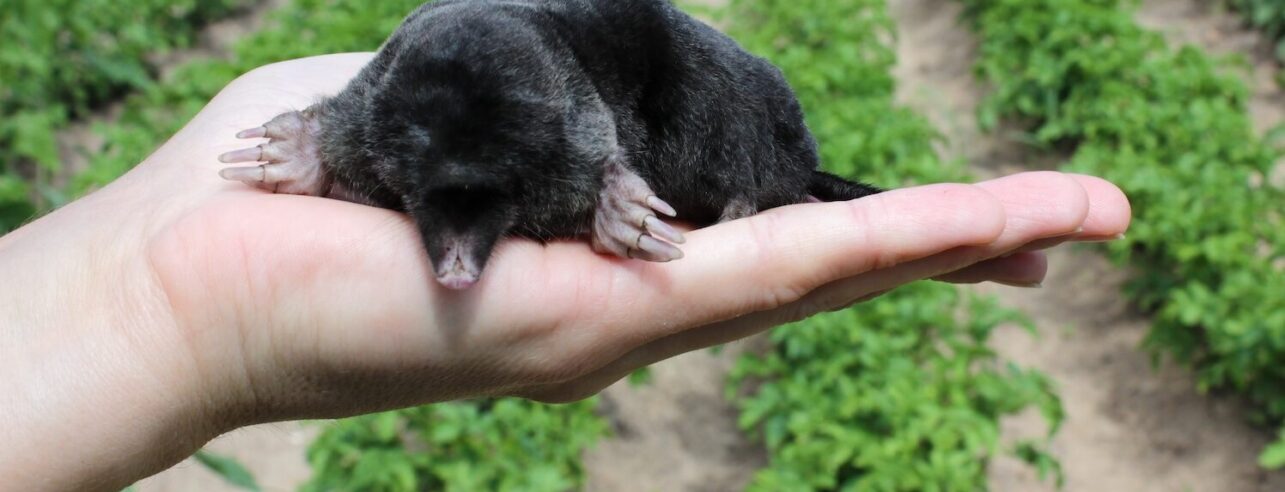
How to get rid of moles from your garden
Moles can be a pest but they're salient beings with feelings. So if you do need to get rid of moles from your garden, adopt the humane approach! Find out how...
🌱 All important maintenance moments for your lawn during the year. Leave your email and we will send you the lawn calendar for free.
Enter your email
Receive the lawn calendar in the mail
Enjoy a green lawn all year round!

- Order by 2PM = shipped today
- 250.000+ satisfied customers!
- 60 day satisfaction guarantee
Moles are super cute, but they can create havoc on your lawn. Of all the pests and vermin, moles leave the most apparent tracks. So, despite being cute little animals humanised by the likes of Wind in the Willows, moles can be a real pest and a barrier to maintaining a beautiful lawn. You need to know how to get rid of moles humanely.
- About the mole
- What are moles good for?
- What damage do moles cause?
- How to get rid of moles in your garden
- More permanent, less humane ways to get rid of garden moles
- Preventing Moles
- How do you restore your lawn after molehills have struck?
- FAQ
A single mole can fill your entire garden with underground passages that emerge as destructive molehills across your lawn’s surface. Not only can they destroy your lawn, but those underground passages can cause:
- Subsidence on your patios and paths
- Broken underground wiring
- Dead plants and trees from gnawed roots
So, moles can be a real problem. This article explores how to prevent a mole party from getting started in the first place and keep them at bay once they’ve packed their bags and left for new climes.
Ready? Let’s get started.
About the mole
What do moles look like?
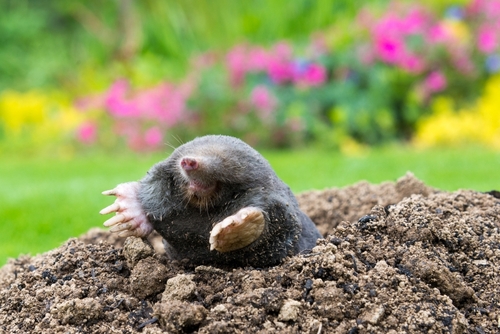
Moles are small, dark grey or black-coloured furry mammals that live underground, with a cylindrical body shape, a small tail, and short limbs. Their pig-like noses and long-nailed feet are the only parts of the mole not covered in fur.
Most people believe that moles are blind and deaf. Neither is true, but their eyesight isn’t as well-developed as other mammals. And it looks like they don’t have ears, but they do – they’re just underneath their fur.
Despite the mole’s poor vision, they have acute hearing and touch, and a masterful sense of smell, helping them find their way underground and avoid danger.
Moles have sharp teeth and powerful front legs, which help them burrow through soil. They rarely sit still – most moles dig at around 14 metres per hour! So, if they live under your garden, that’s a lot of potential damage.
Moles tend to be solitary creatures that spend most of their lives underground. They rarely emerge – infrequently going up to the surface to seek water during drought, mate during the spring, and gather nest materials.
What do moles eat?
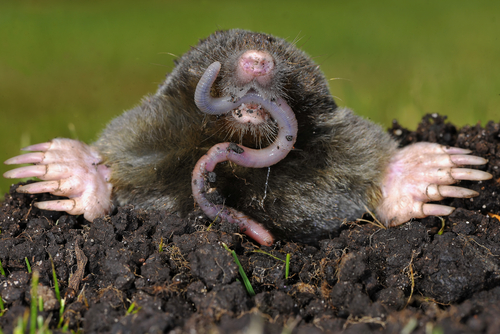
Moles dig tunnels, following their noses for underground food sources, such as worms, leatherjackets, grubs, and other soil-dwelling insects. Earthworms are the moles’ dish of choice, but they’ll eat a range of invertebrates – very occasionally other small mammals.
Land-dwelling moles aren’t solely carnivores – they eat succulent plant parts, such as roots, bulbs, tubers, seeds, and fungi.
Amphibious moles also dine on fish, amphibians, and aquatic invertebrates – some consuming their own body weight in food each day.
So, for the keen gardener, a single mole can cause a real problem – destroying lawns and eating its way through vegetable patches and flowerbeds.
How big are moles?
Most land-dwelling moles found in the UK are between 11cm and 16cm in length, weighing between 72g to 128g.
The average size of a UK mole is 14cm.
Where do moles come from?
Moles are British natives, found commonly throughout England, Scotland, and Wales, with a typical lifespan of three years (up to six years). Oddly, you rarely find moles in Ireland.
Moles are commonly regarded as pests and are often exterminated on farmland to prevent damage to plant roots and farm machinery.
Many farmers trap moles to kill them, which many people consider cruel. Farmers used to poison moles with strychnine, which causes an agonising, slow death.
For this reason, strychnine is now illegal for this purpose.
When are moles most active?
Moles are usually most active in late winter and early spring, but they’re on the move all year round. They’re most active during early mornings and evenings – when the above-soil temperature is at its coolest.
As mentioned, they rarely emerge from underground unless there’s been a recent fresh, warm rainfall.
What are moles good for?
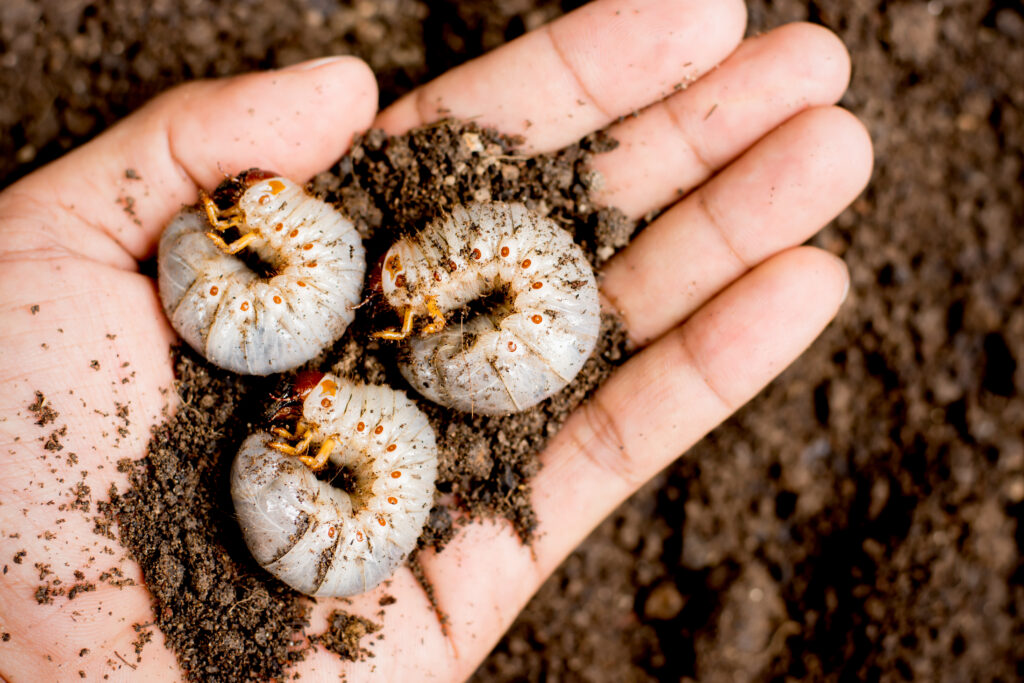
It’s safe to say that moles get a pretty bad rap – people consider them pests, but they can actually benefit the soil.
Moles prey on harmful insect larvae, such as chafer grubs and carrot fly – pests that can decimate a lawn, while their tunnels help aerate and drain garden soil.
Around 31 million moles live in mainland Britain, contributing to soil health – turning, draining, and mixing the topsoil.
Rob Atkinson, the author of Moles (published by Whittet Books), claims that the presence of moles is a good sign, indicating that the soil is healthy.
What damage do moles cause?
Molehills are the most noticeable sign that you have an uninvited mole friend inhabiting your garden. But what exactly is a molehill, and how can you avoid them?
Why do moles build tunnels?
First, it’s helpful to understand why moles build these underground tunnels. Some are temporary, but many of the tunnels they dig are relatively permanent – at least for the lifetime of the mole.
Moles love earthworms, which spend most of their lives underground. Earthworms are very welcome in your garden because they constantly burrow through the earth, effectively aerating your soil. And aerated soil is excellent for your lawn, which needs oxygen at the roots.
So, when earthworms burrow through the earth and hit a mole tunnel, they fall into the void. And it takes them a while to find their way back into the soil. This is the moment: moles use their sense of smell and hearing to detect vibrations in the earth. It means a tasty meal – so mole tunnels are excellent worm traps.
The same happens for other invertebrates – they fall into the void, and the eager mole arrives to help themselves to a little snack.
This means that moles rarely need to emerge to the surface – they have plenty of food underground.
What are molehills?
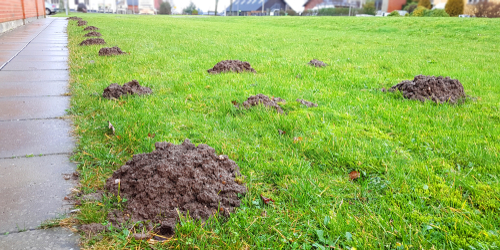
Moles rarely come to the surface, but you’ll notice molehills in early spring and during the autumn. Moles are territorial, solitary animals – they don’t share their tunnel network with other animals. And the only reason they tend to come to the surface is to mate in the spring and release their young in the autumn.
The mole pushes earth to the surface from underground so that they can emerge, creating the molehill.
Other lawn damage caused by molehills
Molehills are the most noticeable damage to a lawn, but you might also notice ridges and depressions in the soil where your mole has built tunnels closer to the surface.
These shallow tunnels can also disturb your grass roots, causing the grass above to dry out and die.
So, while there are some good points to having moles in your lawn soil, the damage often outweighs the benefits.
How to get rid of moles in your garden
We must remember that moles are salient beings, and they have a right to life as much as any other living thing. But, sometimes, it might be better to get them to move on.
Of course, there are ways to permanently rid your garden of moles – mainly by killing them. But for a more humane approach, consider how you can remove them without killing them.
Get rid of moles with garlic
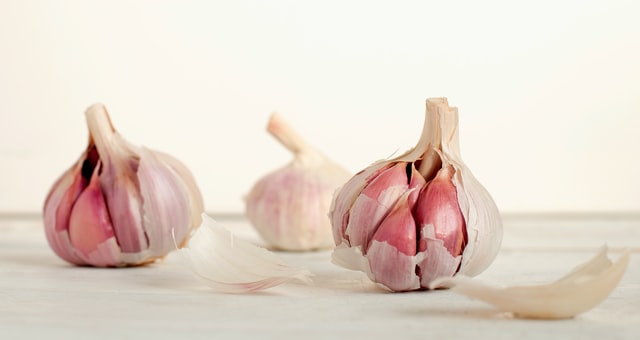
Like vampires and your grandad, moles really dislike the smell of garlic. Moles’ noses are very sensitive, and they can’t bear the smell, which will encourage them to pack their bags and find a home elsewhere.
So, if you’re having a problem with moles, add whole or crushed garlic into the tunnel just below the molehill.
Garlic plants produce the same effect, so if you want a semi-permanent deterrent, plant garlic bulbs around your garden and leave them there. Over the years, they’ll spread – and you can always use the leaves to add a garlicky tang to your cooking.
How to get rid of moles in your garden – scare them with sound
Despite their hidden ears, moles have good hearing, so it’s possible to encourage your garden moles to move on with sounds.
Ultrasonic mole deterrents
Ultrasonic sound is often used to scare cats from your garden, but placed underground, the sound emitted from the device will cause moles to find somewhere else to live. Check out this article for the best ultrasonic mole deterrents.
Repel moles with metal
Hammering a metal pole into the ground above a mole tunnel makes a good mole deterrent. Tie a small metal plate to the top of the pole, and the wind will cause the plate to hit the metal pole continually.
Moles find this sound particularly unpleasant – it will scare them away.
How to get rid of moles with plastic bottles
You know that sound you create when you blow over the rim of a bottle? Well, this is also an excellent mole deterrent.
Grab a few empty plastic bottles – go for 2-litre bottles, as larger bottles create the most resonant sound.
Cut the bottom off the bottle and discard the cap. Insert the open bottom of the bottle into a mole tunnel, ensuring that the top is above ground level and the body of the bottle remains empty of soil.
When the wind blows over the top of the bottle, it will create that unmissable sound, which is further amplified by the shape of the bottle – scaring your moles away.
How to get rid of moles with water
Moles don’t like to be around water, so another way of encouraging moles to move on is to fill the tunnel network with water.
However, mole tunnel networks can be extensive, and you can waste a lot of water if you have the wrong type of soil. If you have sandy soil, this method is unlikely to work, but it should temporarily encourage the moles to pack their bags if you have clay soil.
But this approach is unlikely to be permanent.
How to get rid of moles with a leaf blower
This might seem an odd way to remove moles, but placing the spout of a leaf blower into the mouth of a molehill will create a tremendous amount of noise and unpleasant vibrations that will scare the mole away.
Find the largest molehill – this is likely to be the mouth of the largest tunnel, offering the most effective outcome.
Again, this method might not be permanent – they may return with time.
More permanent, less humane ways to get rid of garden moles
Of course, the most permanent method of getting rid of moles is to kill them. The following methods are ways you can kill a mole. But please go for a quick approach rather than a slow, painful method of eradicating the mole.
Catching moles with a trap
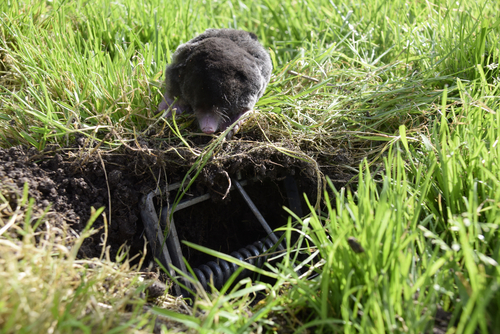
A mole trap is like a mousetrap – just larger. This approach isn’t particularly humane. Mole traps are rarely quick – they often cause a slow, painful death, so please use this as a last resort.
Bury the trap in the tunnel underneath the largest molehill and give it a little time. Eventually, it will permanently solve your mole problem.
How to get rid of moles using a mole tube
A more humane way of moving your mole permanently without killing it is to use a mole tube. This is a long, plastic tube with trapdoors.
Dig the mole tube into a mole tunnel. As soon as the mole walks into the tube, the door will close behind it, trapping it without harming it.
Move the trapped mole to somewhere safe, such as a nearby forest. Try and ensure that there are no signs of other moles nearby – a mole will fight to the death to protect their territory.
Once you’ve buried your mole tube, keep an eye on it. Moles can’t go long without food, so it’s essential they’re not trapped in the pipe for too long.
Use a mole tube correctly, and you can help rehome your mole, so it survives to live on another day.
How to get rid of moles with poison
Again, this is the last resort. And we recommend that you don’t lay poison yourself because you have to be very careful that you don’t damage other animals or people. Applying poison can damage your soil, so this option is best left to a certified professional.
Hire an expert to eradicate your garden moles
If you have a lot of land and an infestation of moles, you might need to go nuclear (not literally). Hire a professional; in this case – search for your local mole control officer online.
Preventing Moles
Prevention is always better than cure, so make your garden inhospitable to these little mammals in the first place. Follow our tips below:
Prevent moles with gauze
If you’re laying a new lawn, you could lay down a mole net in your garden. This is a metal mesh that you dig into the soil around the perimeter of your lawn.
Dig the mesh down to a depth of at least 40cm for best results. And, while it’s a pretty labour-intensive job, you’re almost guaranteed to remain mole free.
Prevent moles with plants
One of the most eco-friendly ways of preventing moles is to adopt an approach of biological warfare – and stink them away with strongly-scented plants.
Moles dislike strong scents; particularly:
- Daffodil
- Marigold – aromatic flowers that contain natural pyrethrins, which repel the bugs and larvae that moles feed upon.
- Crown Imperial – a member of the lily family with large waxy bulbs, the smell of which resembles that of foxes, repelling your mole.
- Stinking hellebore – the smell only releases if you crush the leaves, likened to the smell of wet dog or coffee.
- Cross-leaf spurge
As well as repelling moles, these plants will always brighten up your garden. Win-win.
Prevent moles by mowing regularly
Moles don’t like vibrations. So, by mowing regularly, you keep moles away.
How do you restore your lawn after molehills have struck?
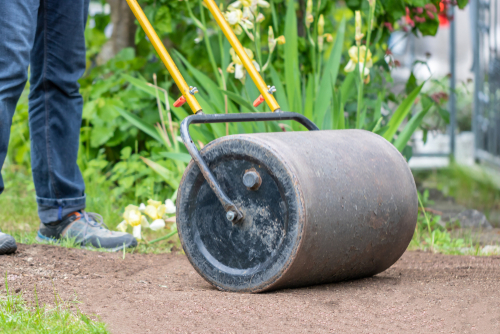
Once you’ve dealt with the problem humanely, you still have a damaged lawn.
Luckily, you can repair molehills relatively quickly with a lawn roller. Push the earth back into the ground and try and fill as much of the tunnel as you can.
Then, lay new grass seed over the bare earth, and fresh grass will appear within a couple of weeks.
If the damage is extensive, you might need to lay your lawn from scratch. Check out our expert articles on laying a new lawn.
Ready to get started? Or do you need more info?
We hope you’ve gained enough insight from our article to tackle your mole problem. But if you have other questions, don’t hesitate to get in touch.
We love to hear from you! We’ll reply to your email as quickly as possible – usually within 48 hours.
Thanks for reading! Happy gardening.
FAQ
Garden moles can seem to appear overnight. They love moist soil rich in earthworms. So if that describes your garden soil, there’s a chance it could attract moles. But there are ways to prevent them from arriving – use a mole net, plant specific strongly-scented plants, or mow regularly to deter them from settling.
The average length of a UK garden mole is 14cm from snout to tail. They can reach up to 16cm in length.
Moles can damage your lawn and your plant life, but they can also benefit your garden soil. Mole tunnels help aerate your ground, and they also eat soil-dwelling insects that can destroy your lawn.
-
Firebugs in the Garden: What now?!Firebugs in your garden? SPOILER ALERT – they're benign! They won't harm you or your garden. Find out how these interesting bugs contribute to your garden's ecosystem.Read more
-
How to Prevent and Control Scale InsectsScale insects are tiny sap-loving insects that can kill your plants if left to their own devices. How to identify them, treat the problem, and nurse your plants back to health after an infestation.Read more
-
How to Prevent and Control Mealybugs on your Plants (and aftercare)Mealybugs look like little fluffy specks of mould, but they'll quickly destroy your house plants or greenhouse plants. Learn how to spot an infestation and what to do to prevent the problem from spreading.Read more
-
Recognise and Control Mares Tail in your garden: from Identification to EradicationMares tail (aka Horsetail) is an invasive weed with deep roots, which make it a real challenge to eradicate. Find out about this fascinating weed (and find out how to tackle the problem).Read more
-
How to get rid of flies: the best tips and tricks!Having flies buzzing around the house is not only annoying, it can pose a significant health hazard. Find out how to get rid of flies without resorting to harsh chemicals and poisons.Read more
-
Whitefly on your plant: Prevention, Control, and TreatmentWhitefly are tiny little insects that quickly kill your plants and attract ants! Find out how to prevent and control an infestation.Read more
-
How to Get Rid of Wasps: Tips and Tricks!Wasps! What a nightmare! While these aggressive little insects offer a painful sting, there's more to the wasp that you might first think. Prevent them arriving with out handy tips.Read more
-
How to Identify, Fight, and Prevent Vine WeevilThe vine weevil is a destructive little pest. Recognise the signs of infestation to prevent the widespread damage this critter can do to your garden plants.Read more
Leave a comment
Your answer will be displayed on the site and the interested party will be notified by email.
Leave a comment
Have a question or want to share your experience? Leave us a comment.

- Order by 2PM = shipped today
- 250.000+ satisfied customers!
- 60 day satisfaction guarantee

- Order by 2PM = shipped today
- 250.000+ satisfied customers!
- 60 day satisfaction guarantee

🌱 All important maintenance moments for your lawn during the year. Leave your email and we will send you the lawn calendar for free.
Enter your email
Receive the lawn calendar in the mail
Enjoy a green lawn all year round!





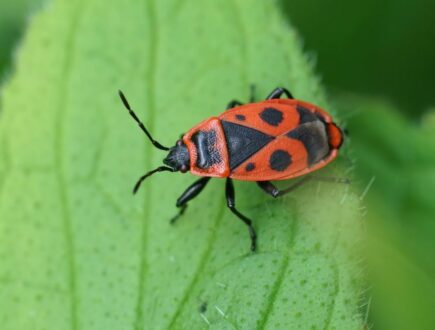



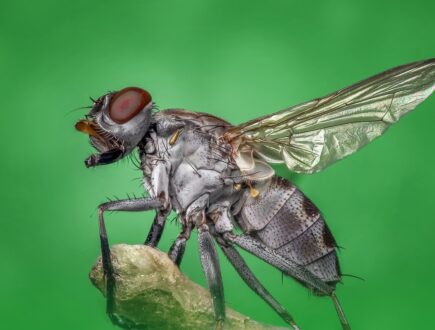
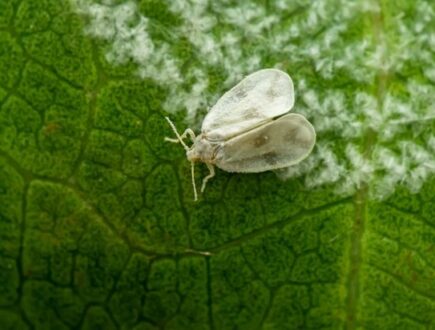

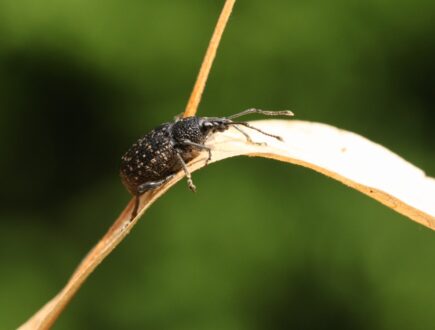









Comments (0)
There are no comments yet. Well then, what are you waiting for to
Be the first to write your comment!inaugurate this pretty page?
Do you have some comments?